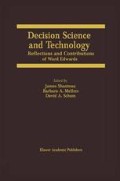Abstract
Formalizing aspects of human judgment under uncertainty in support of decision making is a topic central to the fields of artificial intelligence, decision analysis, and psychology. Automated aids based on probability judgments were first proposed in the 1960s [Edwards, 1962; Edwards et al., 1968], however computers were not sufficiently accessible at that time to make the vision practical. By the 1980s techniques in the artificial intelligence community for expert decision support emphasized logical and deterministic models [de Kleer and Williams, 1987; Genesereth, 1984], as well as non-probabilistic methods [Buchanan and Shortliffe, 1984] for handling uncertainty. Over the last ten years advances in graphical models, such as Bayesian networks [Pearl, 1988] and influence diagrams [Howard and Matheson, 1981], have led to a resurgence in the use of decision-theoretic approaches for automated decision making [Heckerman et al., 1992; Breese et al., 1992; Abramson et al., 1996]. Interest in these methods has been motivated by the recognition that heuristic decision making in complex uncertain environments can lead to suboptimal choices [Tversky and Kahneman, 1974; Kleinmuntz, 1985]. Normative systems constructed on the principles of Bayesian probability, multiattribute utility theory, and decision analysis have great potential for automated reasoning and improving human decision making. This paper is a merging of ideas from decision analysis and techniques for probabilistic reasoning developed in the artificial intelligence community. The methods are being applied on a large scale in automated diagnostic procedures for Microsoft software [Heckerman et al., 1995], thus bringing to fruition the notion of normative decision systems envisioned by Ward Edwards in 1962.
Access this chapter
Tax calculation will be finalised at checkout
Purchases are for personal use only
Preview
Unable to display preview. Download preview PDF.
References
Abramson, B., Brown, J., Edwards, W., Murphy, A., and Winkler, R. (1996). Hailfmder: A Bayesian system for forecasting severe weather. International Journal of Forecasting, 12:57–71.
Balke, A. and Pearl, J. (1994). Probabilistic evaluation of counterfactual queries. In Proceedings of Tenth Conference on Uncertainty in Artificial Intelligence, Seattle, WA, pages 46–54. Morgan Kaufmann.
Breese, J., Horvitz, E., Peot, M., Gay, R., and Quentin, G. (1992), Automated decision-analytic diagnosis of thermal performance in gas turbines. In Proceedings of the International Gas Turbine and Aeroengine Congress and Exposition, Cologne, Germany. American Society of Mechanical Engineers.
Buchanan, B. and Shortliffe, E., editors (1984). Rule-Based Expert Systems: The MYCIN Experiments of the Stanford Heuristic Programming Project. Addison-Wesley, Reading, MA.
de Kleer, J. and Williams, B. (1987). Diagnosing multiple faults. Artificial Intelligence, 32:97–130.
Edwards, W. (1962). Dynamic decisionmaking and probabilistic information processing. Human Factors, 4:59–73.
Edwards, W., Phillips, L. D., Hays, W. L., and Goodman, B. C. (1968). Probabilistic information processing systems: Design and evaluation. IEEE Transactions on Systems Science and Cybernetics, SSC-4:248–265.
Genesereth, M. (1984). The use of design descriptions in automated diagnosis. Artificial Intelligence, 24:311–319.
Goldszmidt, M. and Darwiche, A. (1994). Action networks: A framework for reasoning about actions and change under uncertainty. In Proceedings of Tenth Conference on Uncertainty in Artificial Intelligence, Seattle, WA, pages 136–144. Morgan Kaufmann.
Heckerman, D. and Breese, J. (1996). Causal independence for probability assessment and inference using Bayesian networks. IEEE, Systems, Man, and Cybernetics, 26:826–831.
Heckerman, D., Breese, J., and Rommelse, K. (1994). Sequential troubleshooting under uncertainty. In Proceedings of Fifth International Workshop on Principles of Diagnosis, New Paltz, NY, pages 121–130.
Heckerman, D., Breese, J., and Rommelse, K. (1995). Decision-theoretic troubleshooting. Communications of the ACM, 38:49–57. Heckerman, D., Horvitz, E., and Nathwani, B. (1992). Toward normative expert systems: Part I. The Pathfinder project. Methods of Information in Medicine, 31: 90–105.
Heckerman, D. and Shachter, R. (1995). Decision-theoretic foundations for causal reasoning. Journal of Artificial Intelligence Research, 3:405–430.
Howard, R. (1967). Value of information lotteries. IEEE Transactions of Systems Science and Cybernetics, SSC-3(l):54–60.
Howard, R. and Matheson, J. (1981). Influence diagrams. In Howard, R. and Matheson, J., editors, Readings on the Principles and Applications of Decision Analysis, volume II, pages 721–762. Strategic Decisions Group, Menlo Park, CA.
Kleinmuntz, D. (1985). Cognitive heuristics and feedback in a dynamic decision environment. Management Science, 31:680–702.
Pearl, J. (1988). Probabilistic Reasoning in Intelligent Systems: Networks of Plausible Inference. Morgan Kaufmann, San Mateo, CA.
Pearl, J. (1993). From conditional oughts to qualitative decision theory. In Proceedings of Ninth Conference on Uncertainty in Artificial Intelligence, Washington, DC, pages 12–20. Morgan Kaufmann.
Srinivas, S. (1993). A generalization of the Noisy-Or model. In Proceedings of Ninth Conference on Uncertainty in Artificial Intelligence, Washington, DC, pages 208–215. Morgan Kaufmann.
Tversky, A. and Kahneman, D. (1974). Judgment under uncertainty: Heuristics and biases. Science, 185:1124–1131.
Author information
Authors and Affiliations
Editor information
Editors and Affiliations
Rights and permissions
Copyright information
© 1999 Springer Science+Business Media New York
About this chapter
Cite this chapter
Breese, J.S., Heckerman, D. (1999). Decision-Theoretic Troubleshooting: A Framework for Repair and Experiment. In: Shanteau, J., Mellers, B.A., Schum, D.A. (eds) Decision Science and Technology. Springer, Boston, MA. https://doi.org/10.1007/978-1-4615-5089-1_15
Download citation
DOI: https://doi.org/10.1007/978-1-4615-5089-1_15
Publisher Name: Springer, Boston, MA
Print ISBN: 978-1-4613-7315-5
Online ISBN: 978-1-4615-5089-1
eBook Packages: Springer Book Archive

